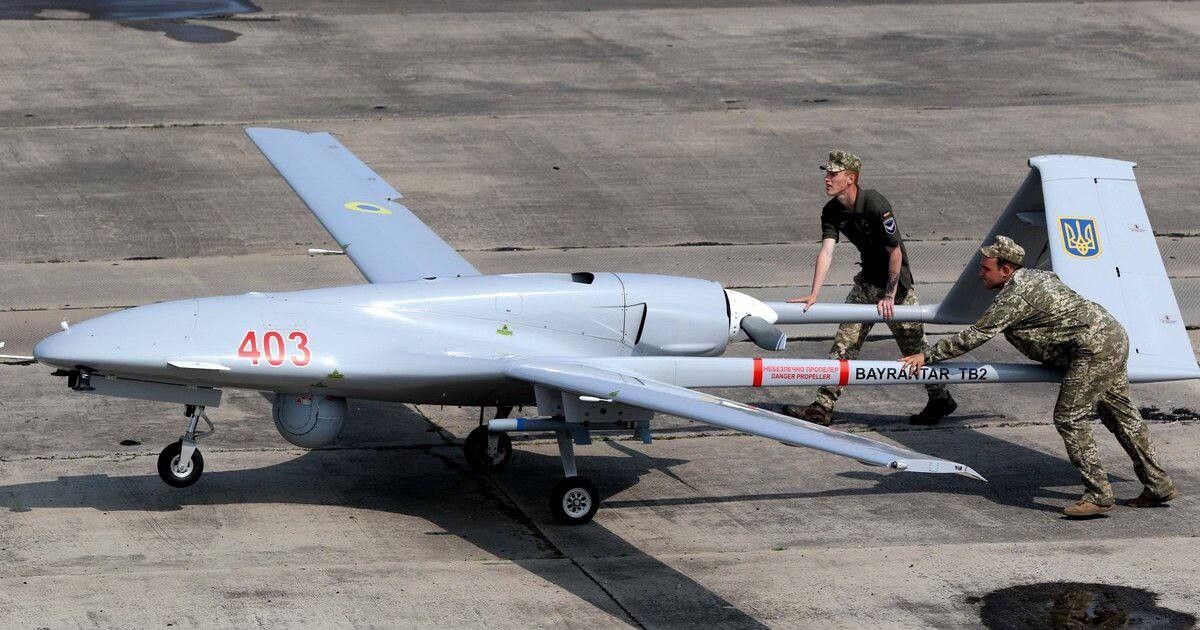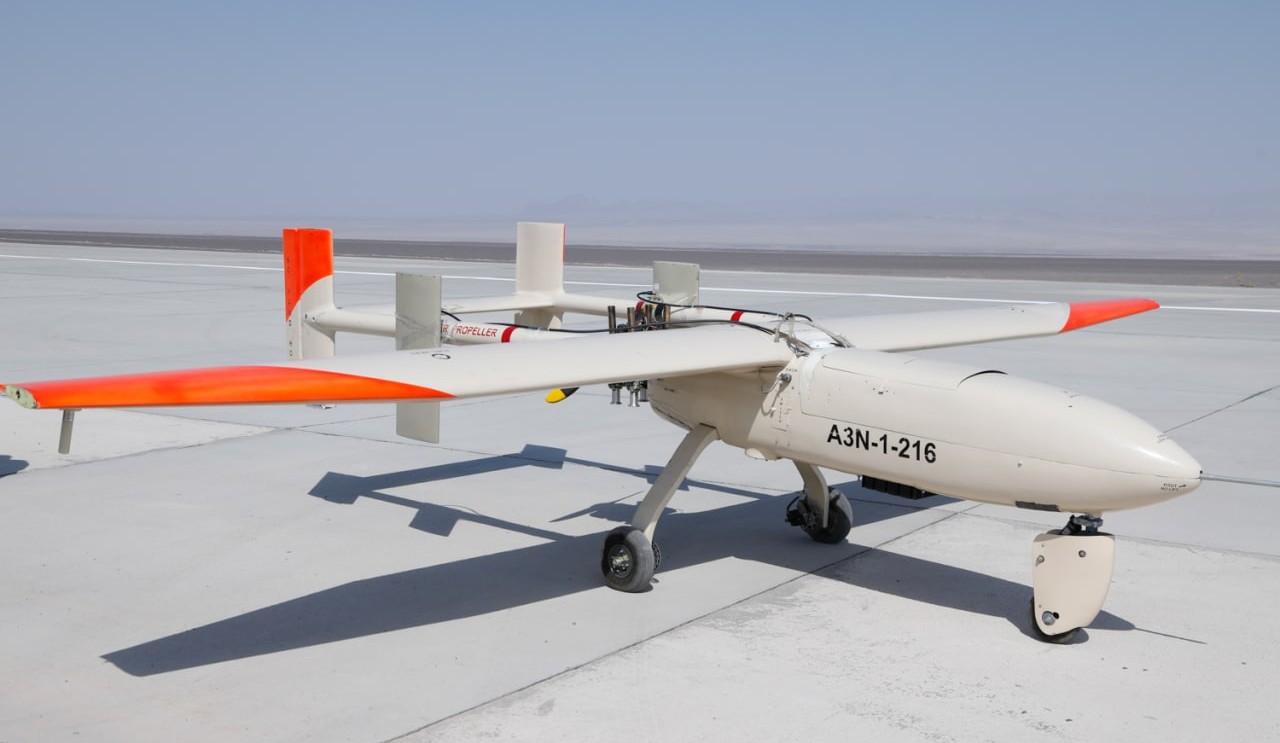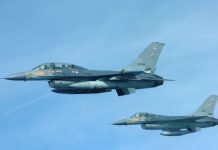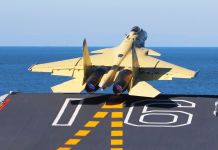The Syrian Rights Monitor reported on October 23 that an airstrike near Damascus destroyed an Iranian-backed drone manufacturing and weapons storage site.
Israel is believed to have undertaken the strike in the darkness of the night. It targeted equipment used for assembling Iranian drones at Dimas military airport near the Lebanese border, the Rights Monitor claimed. A radar and runway were also apparently damaged.
Hezbollah, the proxy sponsored and backed by Iran, has used the Dimas military airport as a base of operations throughout much of the Syrian civil war.
In January, the Syrian Observatory sources reported that Iran and Hezbollah were expanding the site and excavating underground storage sites.
Al Arabiya, a Saudi newspaper, reported that Hezbollah’s Unit 4400 was assigned to transfer military equipment to Hezbollah in cooperation with the Iranian Revolutionary Guards operating the targeted facilities.
There are varying reports about the number of casualties. The Syrian state news says five soldiers were killed in the Israeli airstrike, whereas other sources put the number at eighteen.
New War Weapon
The conflict in Syria has been witnessing drone attacks for quite some time. The Syrian Observatory said that though this was the first such attack in over a month, there were no human casualties.
The Observatory, monitoring violence in Syria since 2011, added that the target was an arms shipment heading for Iranian proxy militias. Nevertheless, it reported that the picture of drone manufacturing and weapons storage sites close to Lebanon and the Israeli border is too complicated.
Unmanned aerial vehicles (UAVs), commonly known as drones, have been widely used in recent armed conflicts, particularly in the Middle East. This low-cost but very effective machine has become popular in battle and surveillance.
Its efficacy was realized in the Azerbaijan-Armenia war in which the former country’s military used the Turkish Bayraktar drones in their attacks on Armenian tanks and military hardware.
Many countries in the region, including Israel, Turkey, Iran, and Saudi Arabia, have been aggressively using and marketing drones. It is a new weapon used by countries and organizations that do not have access to advanced fighter jets.
They are also used by wealthy countries, which find them a valuable alternative to sophisticated but costly human-crewed fighter jets.

Turkey-made Bayraktar drone has invited the attention of military observers as a new weapon in modern warfare. Many countries are trying to access Turkey’s machine. At the same time, many countries are trying to upgrade their drone technology to float a very effective lethal weapon.
Pakistan is one of the countries to acquire the Turkish drone and deploy these for dropping arms, ammunition, medicines, and even Indian currency notes at identified places on the Indian side of the LoC in J&K.
Numerous instances of arms dropping have come to the notice of Indian authorities, and some of the drones have been shot down by the Indian security forces.
Only a few days ago, the J&K Police captured three persons assigned to collect the arms and ammunition dropped by the Pakistani drones at an identified place close to the border in the Samba district of Jammu Division.
Middle East And The Drone
But the real competition in manufacturing and deploying drones of far more power and functionalities compared to what is available now is between Iran and Israel, two countries hostile to each other for several decades.
In the words of Jack Khoury, the columnist for Haaretz, “While Iran tries to compensate for its isolation from military suppliers and high technology weaponry by developing drones and supplying them to its proxies around the Middle East, Israel boasts a highly advanced repertoire of drones that are being marketed around the world, and to some Arab countries. This competition is slowly but surely changing the nature of warfare and thereby altering the region’s geopolitical map.”
Groups like Hamas and Islamic Jihad in Gaza, Hezbollah in Lebanon, the Houthis in Yemen, and pro-Iran militias in Iraq assemble the machine from the drone kits smuggled or otherwise sent to them by Iran.
Last July, Israeli intelligence agencies were reported to have known and destroyed an Iranian drone assembly factory in Syria, which was used to distribute the UAVs to allies in the region.
What is more alarming is that the non-state actors such as the Houthis, Hezbollah, Lashkar-i-Tayyaba, and Jaish-e-Muhammad — the last two based in Pakistan — also use drones armed with missiles (including guided missiles in the case of the former two groups) against targets such as Israel, US bases or tankers in and around the Middle East, and Gulf Cooperation Council countries.
Between 2015 and 2021, the Houthis are reported to have fired 430 ballistic missiles and launched 851 armed drones into Saudi Arabia, killing 59 Saudi civilians, according to the Saudi-led coalition in Yemen’s spokesperson, who also said that Iran and Hezbollah supplied the drones.

Israel Vs. Iran & Proxies
Why have drones become famous as a war weapon with the Third World countries, and in some cases, with non-state actors in particular?
Firstly, the non-state actors — from bona fide liberation movements to terrorist organizations — do not have the necessary funding or the operational capacity to purchase expensive fighter jets. Secondly, many drones can evade radar.
They are generally small in size, can fly at low altitudes, and, as such, are not detectable by the radar. Their targets may possess highly advanced anti-aircraft and anti-missile defense, but the drones go undetected.
Drones are usually not sound-producing machines. As aerial spies, they are helpful to countries and organizations not having the human resource to do the spying with many risks to human intelligence operatives.
In the aftermath of the Arab-Israeli war of 1973, Israel found it necessary to develop drones to gather real-time intelligence on its enemies. Israel has had operational drones for decades now and shows no sign of slowing its pace of development.
ET reported in 2019 that roughly 50 local Israeli start-up companies were working on drone prototypes, with the country’s drone industry worth billions of dollars. And according to a study by a specialist firm, Israel was the world’s leading exporter of drones between 2005 and 2013.
Iran’s proxies have used drones for military purposes ranging from surveillance and reconnaissance to carrying bombs and guided missiles. They have also focused on improving their drone technology and expanding its uses.
Israel has not deviated from its policy of pre-empting the attacks from either Iranian or Iranian proxy drone attacks. In 2019, when Israel attacked and destroyed a drone complex, Prime Minister Netanyahu tweeted, “I reiterate: Iran has no immunity anywhere. Our forces operate in every sector against Iranian aggression. If someone rises to kill you, kill him first.”
Iran has half a dozen primary proxies in the Middle East and the Gulf. They have used drones for military purposes ranging from surveillance and reconnaissance to carrying bombs and guided missiles. These proxies cannot purchase fighter jets; therefore, they want to improve drone technology.
Iranian Drones In Tajikistan
Israeli military planners consider Iranian drones a real threat. They justified the action of the July attacks by stating that its troops shot down three drones used by Hezbollah in an attempted attack on an Israeli gas exploration rig in contested maritime waters with Lebanon.
The Iranian drone industry is also spreading to other countries. In May 2022, Iran opened a drone factory in Tajikistan that produces the Ababil-2 drone capable of reconnaissance and combat.

In September 2022, the Iranian Navy seized two US naval drones, which the United States persuaded it to hand back after a show of force.
The incident has stoked US fears regarding the increasing armament of Iran and its proxies with aerial and naval drones, in addition to their tried-and-true use of ballistic missiles.
Tajikistan is the only Central Asian Republic where a sister language of Iranian, namely Tajik, is spoken. Moreover, both Tajikistan and Iran are in unison in opposing the rise of the Taliban in Afghanistan.
While Tajikistan supports the warriors of Panjshir Valley, the Iranians have demonstrated fraternal ties with the Hazara of Afghanistan. The two countries have thus made a common cause against the Taliban of Afghanistan.
Iran has also provided its proxies with the drones manufactured by Hamas, Hezbollah, and possibly the Houthis to build their drone factories, usually copies of Iranian drones, but are given new names to distance Iran from their actions.
Hamas has engaged Israel with its drones over the past several years, so Hamas drones have even managed to enter Israel and return safely to Gaza.
Imagine when these proxies can manufacture their drones. What would it mean for the security of the vast region called the Middle East? Because the proxies are not answerable to anybody, they care least for human rights.
Hamas and Hezbollah have been developing and operating drones targeting Israel since 2004. Their drone technologies originated in Iran, which has maintained an active military drone program since its war with Iraq.
And reports also indicate that Iran has dramatically increased the military capabilities of its drones in recent years and has been exporting drones to countries in Africa and Central America. Iran’s most recent drone transaction is with Russia, reportedly deploying these in the war against Ukraine.
Escalation
Iran’s urge to develop drone technology and operate drones comes from her belief that Israel has superior air power and capability. Israel has been attacking her production centers, and thus, drone attacks escalated.
In a television broadcast of May 2022, Iran showed footage of a drone base beneath its Zagros mountain range that reportedly contained “more than 100 combat, reconnaissance and attack drones.”
Haaretz reported that In July 2022, Russian President Vladimir Putin visited Iran to meet with Turkish President Recep Tayyip Erdogan and Iranian President Ebrahim Raisi to discuss coordination strategies in Syria.
Iran wanted Russia to flex its aerial military superiority over Syria by refusing to allow Israel the freedom to attack Syrian, Iranian, and Hezbollah targets on Syrian soil.
Putin’s visit was also intended to ensure that Iran provides Russia with as many weaponized drones as possible since Putin and his generals have realized that they are behind in developing and manufacturing what a valuable and inexpensive field weapon is.
Concluding this analysis, it must be remembered that we are now in the drone era of modern warfare. Drone technology is perhaps going to be a critical and comprehensive technology.
Drones’ effectiveness and popularity, as we find in the Middle East, have sent military strategists and arms producers a clear signal that inexpensive drones have the potential to confront armies and wreak havoc on unsuspecting targets miles away.
Should good sense prevail on world leaders, drones might be put to positive use instead of making a war machine. Due to drones’ negative capability, humans might change their mentality and consider putting it to constructive and beneficial use.
- Padma Shri KN Pandita is the former Director of the Centre of Central Asian Studies at Kashmir University. Views expressed here are of the author’s.
- Mail EurAsian Times at etdesk(at)eurasiantimes.com
- Follow EurAsian Times on Google News




